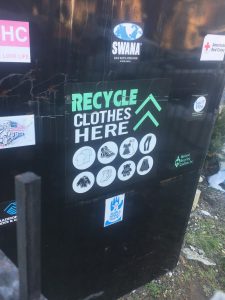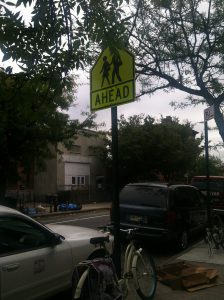Before I get into depth about kerning in my neighborhood, some of the pictures here are from when I used to take a photography class in my last year of high school. Not once have I realized or notice the significance of kerning. Ever since I started taking this class i never realized how kerning and typography was all around me. Here are some photos from the neighborhoods i used to live in and the neighborhood i currently. In the first image about recycling clothes i never realized how perfectly spaced even the small words in the font of the text. The word “Recycle” itself took my attention the most, mostly because it’s written in caps and in my eyes its kerned better than all the other words written down below/ on top of it. The 2nd image is a common a sign that you can spot in multiple neighborhoods but i just like the fact that its in a yellow background that brings out the text/even better. The kerning of the text in this sign in my eyes i think is really important since the texts cant be too close nor to far mainly because if its too close it’ll be too difficult for anyone to read unless they are up close, and if its to spaced out the letters wouldn’t necessarily be comprehensible. With that being said i personally think kerning is a really important tool that can be used in pretty much anything in society. My last message is free writting words/graffiti that doesn’t necessarily have any kerning which proves to be difficult to understand. Not to mention that there isn’t any spacing between any of these multiple type faces. In conclusion Kerning is every where even the places we least expect as long as there is texts there. Kerning is important since it can bring out the depending how you space out the letters. Im personally grateful since because imagining not having kerning in our society everything would just be munched up together.
Author: Brian Gaston
Calendar of Posts
| S | M | T | W | T | F | S |
|---|---|---|---|---|---|---|
| 1 | 2 | 3 | 4 | 5 | 6 | |
| 7 | 8 | 9 | 10 | 11 | 12 | 13 |
| 14 | 15 | 16 | 17 | 18 | 19 | 20 |
| 21 | 22 | 23 | 24 | 25 | 26 | 27 |
| 28 | 29 | 30 | ||||
 Updates from Smash Magazine
Updates from Smash Magazine
- Converting Plain Text To Encoded HTML With Vanilla JavaScriptWhat do you do when you need to convert plain text into formatted HTML? Perhaps you reach for Markdown or manually write in the element tags yourself. Or maybe you have one or two of the dozens of online tools that will do it for you. In this tutorial, Alexis Kypridemos picks those tools apart […]
- How To Monitor And Optimize Google Core Web VitalsThe three Core Web Vitals metrics don’t only tell you how visitors experience your website but also impact your Google search result rankings. In this article, we’ll look at what Core Web Vitals are, how they are measured, and how you can use DebugBear to monitor them continuously.
- Sliding 3D Image Frames In CSSCreating 3D effects in CSS isn’t an entirely new concept, but typical approaches use additional elements in the markup and pseudo-elements in the styles to pull it off. Temani Afif applies 3D effects and sliding transitions to a single `` using clever CSS techniques that demonstrate advanced, modern styling practices.
- Penpot’s CSS Grid Layout: Designing With SuperpowersPenpot helps designers and developers work better together by offering a free, open-source design tool based on open web standards. Today, let's explore Penpot’s latest feature, CSS Grid Layout. Penpot’s latest release is about efficiency and so much more. It gives designers superpowers and a better place at the table. Excited? Let’s take a look […]
- Connecting With Users: Applying Principles Of Communication To UX ResearchVictor Yocco reviews the components of the Transactional Model of communication, explaining how we might apply this framework to preparing, conducting, and analysing our UX research. You will understand how many UX research best practices align with the model and get an example of a tool for tracking alignment.
- The Things Users Would Appreciate In Mobile AppsWhat can we do to make a mobile app better? What subsidiary features are worth providing for our users? I have some ideas. You might, too. So, let’s compare our notes. Without any prescriptions attached, here are seven features I believe can palpably improve a user’s experience with a mobile app.
 How Design News
How Design News
- An error has occurred, which probably means the feed is down. Try again later.






Recent Comments